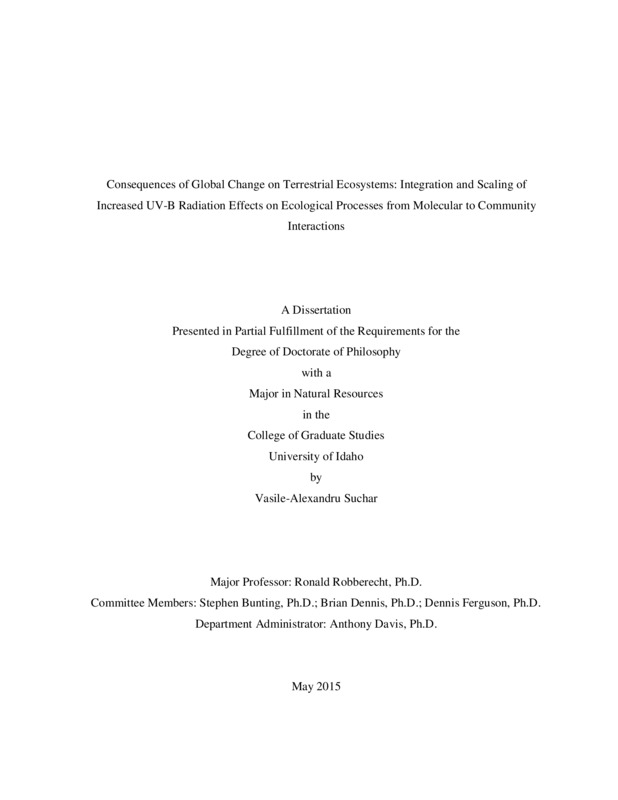Consequences of Global Change on Terrestrial Ecosystems: Integration and Scaling of Increased UV-B Radiation Effects on Ecological Processes from Molecular to Community Interactions
Suchar, Vasile Alexandru. (2015). Consequences of Global Change on Terrestrial Ecosystems: Integration and Scaling of Increased UV-B Radiation Effects on Ecological Processes from Molecular to Community Interactions. Theses and Dissertations Collection, University of Idaho Library Digital Collections. https://www.lib.uidaho.edu/digital/etd/items/suchar_idaho_0089e_10580.html
- Title:
- Consequences of Global Change on Terrestrial Ecosystems: Integration and Scaling of Increased UV-B Radiation Effects on Ecological Processes from Molecular to Community Interactions
- Author:
- Suchar, Vasile Alexandru
- Date:
- 2015
- Keywords:
- global change increased UV-B radiation integration and scaling simulation modeling
- Program:
- Natural Resources
- Subject Category:
- Ecology; Plant sciences
- Abstract:
-
This is the first mathematical model to integrate the effects of increased UV-B radiation through molecular level processes, whole plant growth and development, and community interactions. The model simulations showed that increased UV-B radiation-induced DNA damage significantly delayed cell division until the injury is repaired, resulting in significant reductions in leaf growth and development. Also, it significantly inhibited plant growth by delaying leaf expansion processes and increasing plant metabolic rates and/or reducing the photosynthesis rate. The costs of effective epidermal UV-B radiation absorptive compounds did not result in any significant changes in plant growth, but any associated metabolic costs can effectively reduce the potential plant biomass. There are significant interactions between UV-B radiation, temperature and any factor leading to inhibition of photosynthetic production or plant growth during the daytime, but the effects were not cumulative for all factors. Vegetative growth was significantly delayed in species that do not exhibit reproductive cycles during a growing season, but vegetative growth and reproductive yield in species completing their life cycle in one growing season did not appear to be delayed more than two to five days. The model showed significant differences between growth forms in the increased UV-B radiation effects of growth. In communities, the UV-B radiation sensitive species was constantly outcompeted by the resistant species. But small morphological and physiological changes can cancel the resistant species competitive advantage. A review of the relevant literature showed a wide range of values for the key parameters. Moreover, certain parameter values were inferred only from the calibration process. However our model allowed the testing of several to examine a variety of questions that were difficult to approach through experimental research.
- Description:
- doctoral, Ph.D., Natural Resources -- University of Idaho - College of Graduate Studies, 2015
- Major Professor:
- Robberecht, Ronald
- Committee:
- Bunting, Stephen; Dennis, Brian; Ferguson, Dennis
- Defense Date:
- 2015
- Identifier:
- Suchar_idaho_0089E_10580
- Type:
- Text
- Format Original:
- Format:
- application/pdf
- Rights:
- In Copyright - Educational Use Permitted. For more information, please contact University of Idaho Library Special Collections and Archives Department at libspec@uidaho.edu.
- Standardized Rights:
- http://rightsstatements.org/vocab/InC-EDU/1.0/

